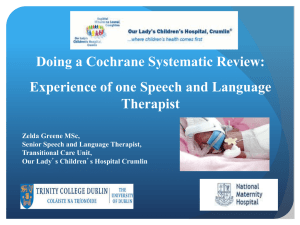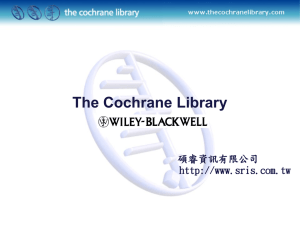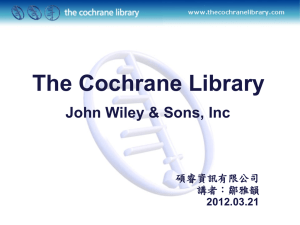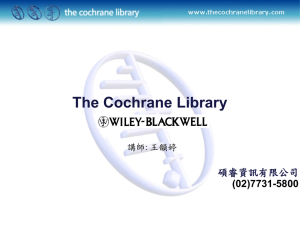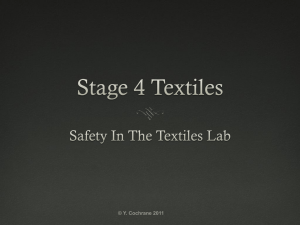Name der Abteilung/Unit maximal 3 Zeilen können hier plaziert
advertisement
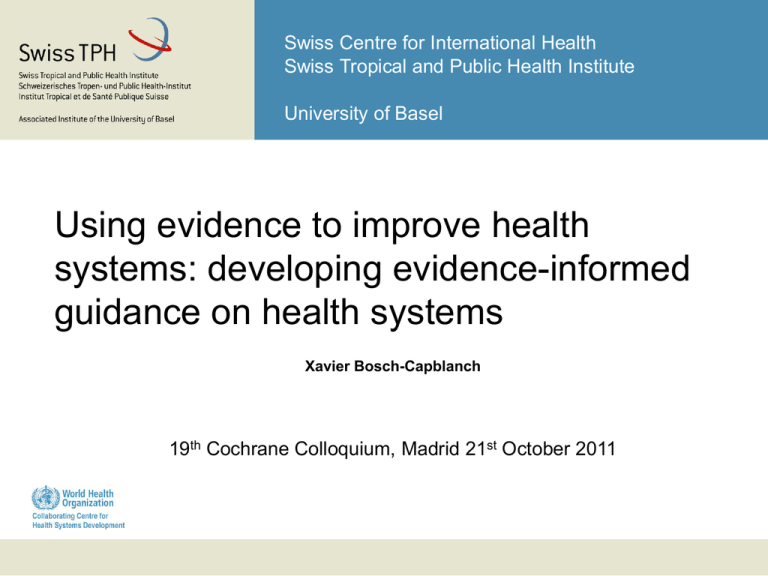
Swiss Centre for International Health Swiss Tropical and Public Health Institute University of Basel Using evidence to improve health systems: developing evidence-informed guidance on health systems Xavier Bosch-Capblanch 19th Cochrane Colloquium, Madrid 21st October 2011 Project: health systems guidance handbook – WHO wanted to develop a handbook to produce health systems guidance – Team: Swiss TPH and NKCHS, assisted by a task force – Approach: adaptation of methods to produce clinical guidelines If imitation is the sincerest way of flattery, the clinicians who promoted evidence-based medicine in the 90s should feel flattered Yamey G, Feachem R. Evidence-based policymaking in global health – the payoffs and pitfalls. BMJ 2011. 2 PICOT in ‘Google’ Francois Edouard Picot - Odalisque (1829) (Stair Sainty Gallery, London) http://www.mypicot.com/ Picots on a tatted insertion. The picots are the small, oval-shaped loops arranged in threes at the top of the tatted material. Wikipedia 3 PICOT in the field of public health Streptococcus pneumoniae is one of the leading causes of invasive disease, bacterial pneumonia and meningitis among children in low-income countries. Participants: healthy infants Intervention: pneumococcal vaccine Comparison: placebo or other vaccines Outcomes: invasive disease, X-Ray penumonia Time: follow up 24 months Lucero MG et al. Pneumococcal conjugate vaccines for preventing vaccine-type invasive pneumococcal disease and X-ray defined pneumonia in children less than two years of age. Cochrane Library. 4 Research question Health systems guidance Participants Timely Intervention Oriented towards policy Comparison Problem driven Outcomes Implementation Time Context 5 P Health system problems may be defined in different ways Quality of care: i) Self-reported outcome measures: a. of health status and health–related quality of life b. of patient satisfaction and experience with the process of care. ii) Clinical behaviours (e.g., prescribing, referrals, treatments) iii) Intermediate clinical and physiological indicators (e.g. blood pressure) Scott A et al. The effect of financial incentives on the quality of health care provided by primary care physicians. Cochrane Library. 6 P Different definitions on quality of care Donabedian 1990 Acceptability Maxwell 1992 HSRG 1992 O'Leary 1992 Patient centeredness Patient perspective Accessibility Accessibility Acceptability Legitimacy Accessibility Equity Equity Efficacy Efficacy Effectiveness Effectiveness Effectiveness Effectiveness Efficiency Efficiency Efficiency Efficiency Continuity / coordination Comprehensiveness Relevance HSRG: Health Services Research Group Campbell SM et al. Soc Sci Med 2000 7 P Scope of problems and interventions Types of interventions: Managerial supervision Types of outcome measures: many (providers, adherence, coverage…) Bosch-Capblanch X et al. Managerial supervision to improve primary health care in low- and middle-income countries. Cochrane Library. Types of interventions: we included any type of intervention that… Types of outcome measures: consumer’s skills for online health literacy Car J et al. Interventions for enhancing consumers' online health literacy. Cochrane Library Problems: Interventions: 8 P Basic health system problems 9 P First step in policymaking process Lavis JN. How Can We Support the Use of Systematic Reviews in Policymaking? PLOS Medicine 2009. Don de Savigny, Adam T. Health Systems Thinking. WHO 10 O What if before starting doing what ought to be done we start doing what we should have done? Quino. Mafalda. http://www.clubcultura.com/clubhumor/mafalda/f rases/frase_felipe.htm 11 O Complexity of evidence 2. when the recommendation is against an intervention and the 95% confidence interval (or alternative estimate of precision) around the pooled or best estimate of effect a. the 95% confidence interval (or alternative estimate of precision) around the pooled or best estimate of effect includes no effect and the lower confidence limit includes an effect that, if it were real, would represent a harm that, given the benefits, would still be unacceptable GRADEProfiler help (3.6) 12 O It is beneficial to give routine malaria chemoprophylaxis in sickle cell disease in areas where malaria is endemic. Oniyangi O et al. Malaria chemoprophylaxis in sickle cell disease. Cochrane Library. All trials demonstrate benefit in attenuating or reducing plasma viral load and/or increasing CD4 counts. Walson JL et al. Deworming helminth co-infected individuals for delaying HIV disease progression. Cochrane Library. …these results indicate that routine surgery cannot be recommended unless within the context of a large, well-conducted randomized controlled trial. Jutte PC et al. Routine surgery in addition to chemotherapy for treating spinal tuberculosis. Cochrane Library. Choice of therapy for second stage Gambiense HAT will continue to be determined by what is locally available, but eflornithine and NECT are likely to replace melarsoprol, with careful parasite resistance monitoring. Lutke V et al. Chemotherapy for second-stage Human African trypanosomiasis. Cochrane Library. Immunoglobulins seem to be effective for pre-exposure and post-exposure prophylaxis of hepatitis A. However, caution is warranted for the positive findings due to the limited number of trials, year of conductance, and risk of bias.. Ping Liu J et al. Immunoglobulins for preventing hepatitis A. Cochrane Library. 13 O It is not possible to draw any conclusions about the effectiveness of strategies to change organisational culture Parmelli E et al. The effectiveness of strategies to change organisational culture to improve healthcare performance. Cochrane Library. The findings suggest interventions relating to hospital nurse staffing models may improve some patient outcomes… However, these findings should be treated with extreme caution due to the limited evidence available from the research conducted to date. Butler M et al. Hospital nurse staffing models and patient and staff-related outcomes. Cochrane Library. There is a need to develop rigorous studies to evaluate the effects of social franchising on access to and quality of health services in low- and middle-income countries. Perez Koehlmoos T et al. The effect of social franchising on access to and quality of health services in low- and middle-income countries. Cochrane Library. The findings of this review do not provide sufficient evidence to support or resist a policy of altering the lengths of primary care physicians' consultations. Wilson AD et al. Effects of interventions aimed at changing the length of primary care physicians' consultation. Cochrane Library. There is insufficient evidence for the effectiveness of stress management training interventions to reduce job stress and prevent burnout among healthcare workers beyond the intervention period. Va Wyk BE et al. Preventive staff-support interventions for health workers. Cochrane Library. 14 O Very diverse audience IMMUNISATION PRACTICES ADVISORY COMMITTEE (TO WHO) - IPAC • • • • • • • • • • • • Associate Director of Surveillance and Epidemiology (Canada) Medical Epidemiologist (Switzerland) Medical doctor (Switzerland) Professor of Engineering (USA) Private Consultant (France) Adjunct Professor Paediatrics (Jordan) Maternal Child Health Programme Manager (Nigeria) Emeritus Professor of Paediatrics (Sri Lanka) Principal Fellow, Maternal and Child Health (Australia) Private Consultant (France) Centre for Data and Epidemiological Surveillance (Indonesia) Immunization Team Leader (USA) And observers from Global Health Initiatives, pharmaceutical industry, Non-Governmental Organisations, Research Institutes… 15 O Annual governmental health budget = (Tajikistan) The tallest unsupported flagpole measures 165 m (541 ft 4 in), and was erected by Trident Support (USA). It was presented and measured in Dushanbe, Tajikistan, on 24 May 2011. (Guiness World Records) 16 O Barriers to the uptake of evidence Evidence-related factors limiting the use of research evidence – “Policy-free” evidence – Undue focus on RCT – Poor local applicability – Lack of focus on social determinants for health – Lack of complexity ‘External factors’ restricting the use of research evidence: – Competing influences – Resources constraints – Stakeholders and public pressure – Community views and local competition Orton L et al. The use of research evidence in public health decision making process: systematic review. PLOS 2011. Decision to introduce Hepatitis B vaccine at birth related to the death a politician’s friend of liver cancer (IPAC meeting 2011). 17 O Adapted contents Plain language summaires The evidence was of low to very low quality and the studies showed mixed results. Compared to no supervision, some studies showed that supervision had a small benefit on health worker practices and knowledge, while other studies showed no benefit or were inconclusive. We are therefore uncertain about the effects of supervision on the quality of primary healthcare services. Bosch-Capblanch X et al. Managerial supervision to improve primary health care in low- and middle-income countries. Cochrane Library. Thanks to Claire Glenton 18 O SUPPORT collaboration Cochrane Consumers and Communication Review Group Centre for Health Communication and Participation 19 O Structured contents 20 O Cosmetic issues Thanks to Sarah Rosenbaum 21 O 22 Implications PICOTs for TOPICs Can Cochrane reviews be made more appropriate for decision making on health systems? – a common taxonomy of HS TOPICs under the policymaking perspective – a common taxonomy of PICOs questions under the research perspective – inclusion of non-effectiveness evidence – a common HS framework to align the approaches of Cochrane reviews on HS interventions 23 Contribution / acknowledgments Project team Xavier Bosch-Capblanch, Swiss TPH Simon Lewin, NKCHS (Norway) Kaspar Wyss, Swiss TPH Lise Beck, Swiss TPH Daniel Dröschel, Swiss TPH Don de Savigny, Swiss TPH Thanks to Paul Garner for reviewing this presentation Taskforce members Edgardo Abalos, CREP (Argentina); Rifat Atun, GFATM Fadi El-Jardali AU Beirut (Lebanon) Timothy Evans, WHO Abdul Ghaffar, AHPSR-WHO Davina Ghersi, WHO Lucy Gilson, UCT (South Africa) Metin Gulmezoglu, WHO Andy Haines (chair), LSHTM (UK) John Lavis, McMaster U (Canada) Regina Kulier, GRC-WHO Sandy Oliver, IOE (UK) Pierre Ongolo-Zogo, CDPBH (Cameroon) Tikki Pang, WHO Ulysses Panisset, WHO John-Arne Røttingen, NKCHS (Norway) Peter Tugwell, IPH (Canada) Gunn Vist, NKCHS (Norway) 24 Thanks for your attention 25

